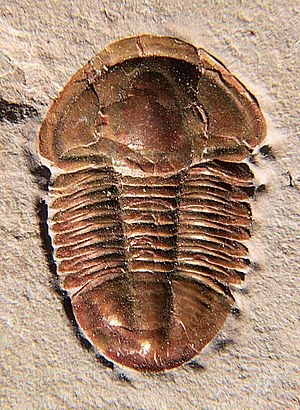Asaphiscus facts for kids
Quick facts for kids Asaphiscus |
|
|---|---|
 |
|
| Asaphiscus wheeleri, Cambrian shale, Utah | |
| Scientific classification | |
| Kingdom: | |
| Phylum: | |
| Class: | |
| Order: |
Ptychopariida
|
| Family: |
Asaphiscidae
|
| Genus: |
Asaphiscus
Meek, 1873
|
| Species | |
| Synonyms | |
|
Eteraspis |
|
Asaphiscus is a genus of trilobite, which are ancient sea creatures that are now extinct. They lived a very long time ago during a period called the Cambrian (about 510 to 499 million years ago!). Their fossil remains have been discovered in places like Australia and North America, especially in Utah.
About Asaphiscus
Asaphiscus was a type of trilobite, which were a group of arthropods. Think of them as distant relatives of today's crabs, lobsters, or insects. They were very common in ancient oceans.
What Did Asaphiscus Look Like?
Asaphiscus was a medium-sized trilobite, usually growing up to about 8 centimeters (about 3 inches) long. Its body was somewhat flat and shaped like an upside-down egg. It was about one and a half times longer than it was wide.
Like all trilobites, Asaphiscus had three main body parts:
- Headshield (Cephalon): This was the front part, shaped like a half-circle. It had wide, rounded corners. The central raised area on the head, called the glabella, was cone-shaped.
- Middle Body (Thorax): This part was made of several segments that could move. Asaphiscus typically had 7 to 11 segments, with 9 segments being common in the species A. wheeleri.
- Tailshield (Pygidium): This was the back part, also shaped like a half-circle. It had a wide, flat border around its edge.
Where Did Asaphiscus Live?
Fossils of Asaphiscus have been found in different parts of the world. The species A. wheeleri is known from the Middle Cambrian rocks in the United States, particularly in Millard County, Utah. Other Asaphiscus fossils have also been found in Australia. These discoveries help scientists understand where these ancient creatures lived and how they spread across the ancient oceans.
Images for kids



